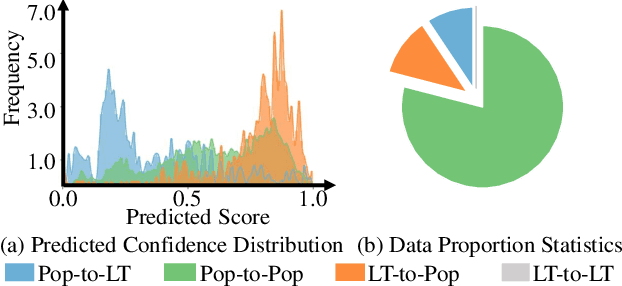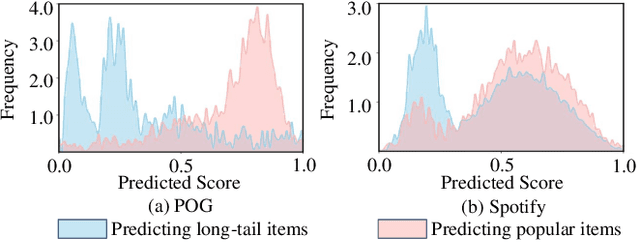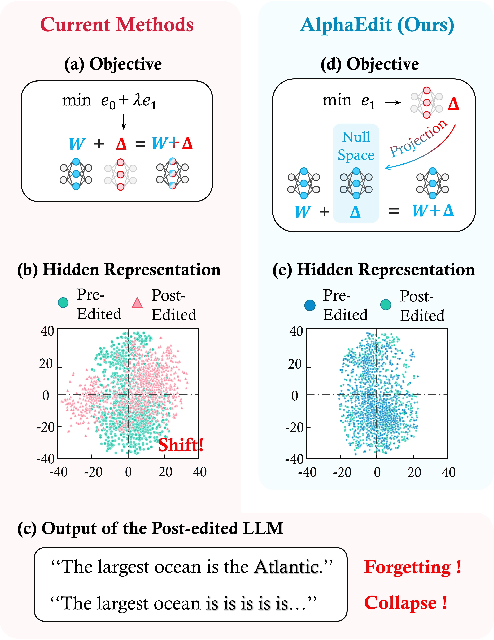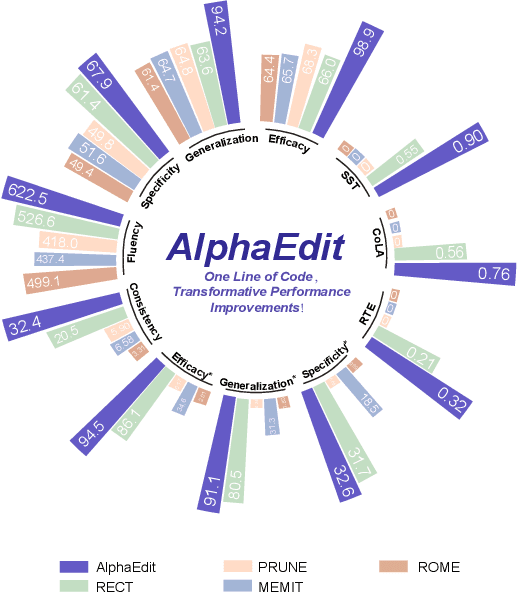Yunshan Ma
SemCORE: A Semantic-Enhanced Generative Cross-Modal Retrieval Framework with MLLMs
Apr 17, 2025Abstract:Cross-modal retrieval (CMR) is a fundamental task in multimedia research, focused on retrieving semantically relevant targets across different modalities. While traditional CMR methods match text and image via embedding-based similarity calculations, recent advancements in pre-trained generative models have established generative retrieval as a promising alternative. This paradigm assigns each target a unique identifier and leverages a generative model to directly predict identifiers corresponding to input queries without explicit indexing. Despite its great potential, current generative CMR approaches still face semantic information insufficiency in both identifier construction and generation processes. To address these limitations, we propose a novel unified Semantic-enhanced generative Cross-mOdal REtrieval framework (SemCORE), designed to unleash the semantic understanding capabilities in generative cross-modal retrieval task. Specifically, we first construct a Structured natural language IDentifier (SID) that effectively aligns target identifiers with generative models optimized for natural language comprehension and generation. Furthermore, we introduce a Generative Semantic Verification (GSV) strategy enabling fine-grained target discrimination. Additionally, to the best of our knowledge, SemCORE is the first framework to simultaneously consider both text-to-image and image-to-text retrieval tasks within generative cross-modal retrieval. Extensive experiments demonstrate that our framework outperforms state-of-the-art generative cross-modal retrieval methods. Notably, SemCORE achieves substantial improvements across benchmark datasets, with an average increase of 8.65 points in Recall@1 for text-to-image retrieval.
FashionDPO:Fine-tune Fashion Outfit Generation Model using Direct Preference Optimization
Apr 17, 2025Abstract:Personalized outfit generation aims to construct a set of compatible and personalized fashion items as an outfit. Recently, generative AI models have received widespread attention, as they can generate fashion items for users to complete an incomplete outfit or create a complete outfit. However, they have limitations in terms of lacking diversity and relying on the supervised learning paradigm. Recognizing this gap, we propose a novel framework FashionDPO, which fine-tunes the fashion outfit generation model using direct preference optimization. This framework aims to provide a general fine-tuning approach to fashion generative models, refining a pre-trained fashion outfit generation model using automatically generated feedback, without the need to design a task-specific reward function. To make sure that the feedback is comprehensive and objective, we design a multi-expert feedback generation module which covers three evaluation perspectives, \ie quality, compatibility and personalization. Experiments on two established datasets, \ie iFashion and Polyvore-U, demonstrate the effectiveness of our framework in enhancing the model's ability to align with users' personalized preferences while adhering to fashion compatibility principles. Our code and model checkpoints are available at https://github.com/Yzcreator/FashionDPO.
Distilling Transitional Pattern to Large Language Models for Multimodal Session-based Recommendation
Apr 13, 2025Abstract:Session-based recommendation (SBR) predicts the next item based on anonymous sessions. Traditional SBR explores user intents based on ID collaborations or auxiliary content. To further alleviate data sparsity and cold-start issues, recent Multimodal SBR (MSBR) methods utilize simplistic pre-trained models for modality learning but have limitations in semantic richness. Considering semantic reasoning abilities of Large Language Models (LLM), we focus on the LLM-enhanced MSBR scenario in this paper, which leverages LLM cognition for comprehensive multimodal representation generation, to enhance downstream MSBR. Tackling this problem faces two challenges: i) how to obtain LLM cognition on both transitional patterns and inherent multimodal knowledge, ii) how to align both features into one unified LLM, minimize discrepancy while maximizing representation utility. To this end, we propose a multimodal LLM-enhanced framework TPAD, which extends a distillation paradigm to decouple and align transitional patterns for promoting MSBR. TPAD establishes parallel Knowledge-MLLM and Transfer-MLLM, where the former interprets item knowledge-reflected features and the latter extracts transition-aware features underneath sessions. A transitional pattern alignment module harnessing mutual information estimation theory unites two MLLMs, alleviating distribution discrepancy and distilling transitional patterns into modal representations. Extensive experiments on real-world datasets demonstrate the effectiveness of our framework.
Large Language Model Empowered Recommendation Meets All-domain Continual Pre-Training
Apr 11, 2025Abstract:Recent research efforts have investigated how to integrate Large Language Models (LLMs) into recommendation, capitalizing on their semantic comprehension and open-world knowledge for user behavior understanding. These approaches predominantly employ supervised fine-tuning on single-domain user interactions to adapt LLMs for specific recommendation tasks. However, they typically encounter dual challenges: the mismatch between general language representations and domain-specific preference patterns, as well as the limited adaptability to multi-domain recommendation scenarios. To bridge these gaps, we introduce CPRec -- an All-domain Continual Pre-Training framework for Recommendation -- designed to holistically align LLMs with universal user behaviors through the continual pre-training paradigm. Specifically, we first design a unified prompt template and organize users' multi-domain behaviors into domain-specific behavioral sequences and all-domain mixed behavioral sequences that emulate real-world user decision logic. To optimize behavioral knowledge infusion, we devise a Warmup-Stable-Annealing learning rate schedule tailored for the continual pre-training paradigm in recommendation to progressively enhance the LLM's capability in knowledge adaptation from open-world knowledge to universal recommendation tasks. To evaluate the effectiveness of our CPRec, we implement it on a large-scale dataset covering seven domains and conduct extensive experiments on five real-world datasets from two distinct platforms. Experimental results confirm that our continual pre-training paradigm significantly mitigates the semantic-behavioral discrepancy and achieves state-of-the-art performance in all recommendation scenarios. The source code will be released upon acceptance.
Extending Visual Dynamics for Video-to-Music Generation
Apr 10, 2025Abstract:Music profoundly enhances video production by improving quality, engagement, and emotional resonance, sparking growing interest in video-to-music generation. Despite recent advances, existing approaches remain limited in specific scenarios or undervalue the visual dynamics. To address these limitations, we focus on tackling the complexity of dynamics and resolving temporal misalignment between video and music representations. To this end, we propose DyViM, a novel framework to enhance dynamics modeling for video-to-music generation. Specifically, we extract frame-wise dynamics features via a simplified motion encoder inherited from optical flow methods, followed by a self-attention module for aggregation within frames. These dynamic features are then incorporated to extend existing music tokens for temporal alignment. Additionally, high-level semantics are conveyed through a cross-attention mechanism, and an annealing tuning strategy benefits to fine-tune well-trained music decoders efficiently, therefore facilitating seamless adaptation. Extensive experiments demonstrate DyViM's superiority over state-of-the-art (SOTA) methods.
AttackSeqBench: Benchmarking Large Language Models' Understanding of Sequential Patterns in Cyber Attacks
Mar 05, 2025Abstract:The observations documented in Cyber Threat Intelligence (CTI) reports play a critical role in describing adversarial behaviors, providing valuable insights for security practitioners to respond to evolving threats. Recent advancements of Large Language Models (LLMs) have demonstrated significant potential in various cybersecurity applications, including CTI report understanding and attack knowledge graph construction. While previous works have proposed benchmarks that focus on the CTI extraction ability of LLMs, the sequential characteristic of adversarial behaviors within CTI reports remains largely unexplored, which holds considerable significance in developing a comprehensive understanding of how adversaries operate. To address this gap, we introduce AttackSeqBench, a benchmark tailored to systematically evaluate LLMs' capability to understand and reason attack sequences in CTI reports. Our benchmark encompasses three distinct Question Answering (QA) tasks, each task focuses on the varying granularity in adversarial behavior. To alleviate the laborious effort of QA construction, we carefully design an automated dataset construction pipeline to create scalable and well-formulated QA datasets based on real-world CTI reports. To ensure the quality of our dataset, we adopt a hybrid approach of combining human evaluation and systematic evaluation metrics. We conduct extensive experiments and analysis with both fast-thinking and slow-thinking LLMs, while highlighting their strengths and limitations in analyzing the sequential patterns in cyber attacks. The overarching goal of this work is to provide a benchmark that advances LLM-driven CTI report understanding and fosters its application in real-world cybersecurity operations. Our dataset and code are available at https://github.com/Javiery3889/AttackSeqBench .
Integrate Temporal Graph Learning into LLM-based Temporal Knowledge Graph Model
Jan 21, 2025Abstract:Temporal Knowledge Graph Forecasting (TKGF) aims to predict future events based on the observed events in history. Recently, Large Language Models (LLMs) have exhibited remarkable capabilities, generating significant research interest in their application for reasoning over temporal knowledge graphs (TKGs). Existing LLM-based methods have integrated retrieved historical facts or static graph representations into LLMs. Despite the notable performance of LLM-based methods, they are limited by the insufficient modeling of temporal patterns and ineffective cross-modal alignment between graph and language, hindering the ability of LLMs to fully grasp the temporal and structural information in TKGs. To tackle these issues, we propose a novel framework TGL-LLM to integrate temporal graph learning into LLM-based temporal knowledge graph model. Specifically, we introduce temporal graph learning to capture the temporal and relational patterns and obtain the historical graph embedding. Furthermore, we design a hybrid graph tokenization to sufficiently model the temporal patterns within LLMs. To achieve better alignment between graph and language, we employ a two-stage training paradigm to finetune LLMs on high-quality and diverse data, thereby resulting in better performance. Extensive experiments on three real-world datasets show that our approach outperforms a range of state-of-the-art (SOTA) methods.
Headache to Overstock? Promoting Long-tail Items through Debiased Product Bundling
Nov 28, 2024



Abstract:Product bundling aims to organize a set of thematically related items into a combined bundle for shipment facilitation and item promotion. To increase the exposure of fresh or overstocked products, sellers typically bundle these items with popular products for inventory clearance. This specific task can be formulated as a long-tail product bundling scenario, which leverages the user-item interactions to define the popularity of each item. The inherent popularity bias in the pre-extracted user feedback features and the insufficient utilization of other popularity-independent knowledge may force the conventional bundling methods to find more popular items, thereby struggling with this long-tail bundling scenario. Through intuitive and empirical analysis, we navigate the core solution for this challenge, which is maximally mining the popularity-free features and effectively incorporating them into the bundling process. To achieve this, we propose a Distilled Modality-Oriented Knowledge Transfer framework (DieT) to effectively counter the popularity bias misintroduced by the user feedback features and adhere to the original intent behind the real-world bundling behaviors. Specifically, DieT first proposes the Popularity-free Collaborative Distribution Modeling module (PCD) to capture the popularity-independent information from the bundle-item view, which is proven most effective in the long-tail bundling scenario to enable the directional information transfer. With the tailored Unbiased Bundle-aware Knowledge Transferring module (UBT), DieT can highlight the significance of popularity-free features while mitigating the negative effects of user feedback features in the long-tail scenario via the knowledge distillation paradigm. Extensive experiments on two real-world datasets demonstrate the superiority of DieT over a list of SOTA methods in the long-tail bundling scenario.
AlphaEdit: Null-Space Constrained Knowledge Editing for Language Models
Oct 03, 2024



Abstract:Large language models (LLMs) often exhibit hallucinations due to incorrect or outdated knowledge. Hence, model editing methods have emerged to enable targeted knowledge updates. To achieve this, a prevailing paradigm is the locating-then-editing approach, which first locates influential parameters and then edits them by introducing a perturbation. While effective, current studies have demonstrated that this perturbation inevitably disrupt the originally preserved knowledge within LLMs, especially in sequential editing scenarios. To address this, we introduce AlphaEdit, a novel solution that projects perturbation onto the null space of the preserved knowledge before applying it to the parameters. We theoretically prove that this projection ensures the output of post-edited LLMs remains unchanged when queried about the preserved knowledge, thereby mitigating the issue of disruption. Extensive experiments on various LLMs, including LLaMA3, GPT2-XL, and GPT-J, show that AlphaEdit boosts the performance of most locating-then-editing methods by an average of 36.4% with a single line of additional code for projection solely. Our code is available at: https://github.com/jianghoucheng/AlphaEdit.
MM-Forecast: A Multimodal Approach to Temporal Event Forecasting with Large Language Models
Aug 08, 2024Abstract:We study an emerging and intriguing problem of multimodal temporal event forecasting with large language models. Compared to using text or graph modalities, the investigation of utilizing images for temporal event forecasting has not been fully explored, especially in the era of large language models (LLMs). To bridge this gap, we are particularly interested in two key questions of: 1) why images will help in temporal event forecasting, and 2) how to integrate images into the LLM-based forecasting framework. To answer these research questions, we propose to identify two essential functions that images play in the scenario of temporal event forecasting, i.e., highlighting and complementary. Then, we develop a novel framework, named MM-Forecast. It employs an Image Function Identification module to recognize these functions as verbal descriptions using multimodal large language models (MLLMs), and subsequently incorporates these function descriptions into LLM-based forecasting models. To evaluate our approach, we construct a new multimodal dataset, MidEast-TE-mm, by extending an existing event dataset MidEast-TE-mini with images. Empirical studies demonstrate that our MM-Forecast can correctly identify the image functions, and further more, incorporating these verbal function descriptions significantly improves the forecasting performance. The dataset, code, and prompts are available at https://github.com/LuminosityX/MM-Forecast.
 Add to Chrome
Add to Chrome Add to Firefox
Add to Firefox Add to Edge
Add to Edge